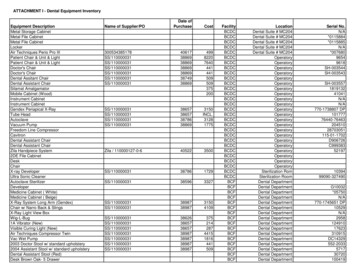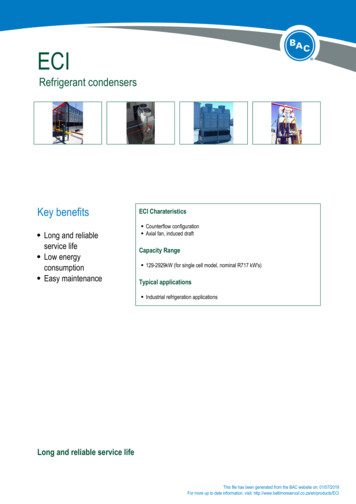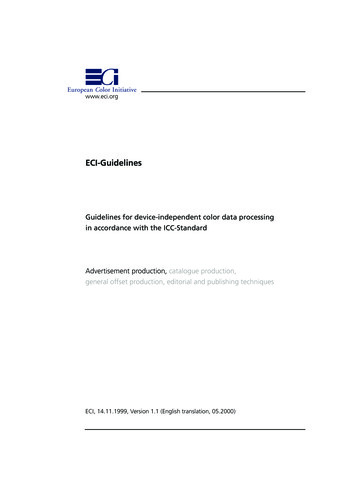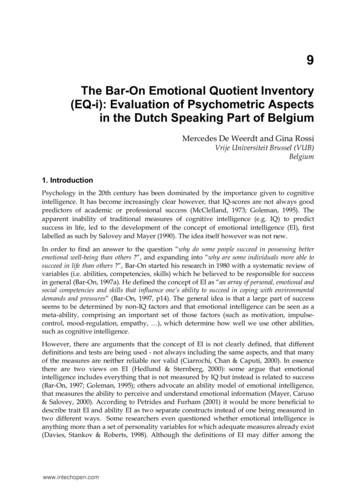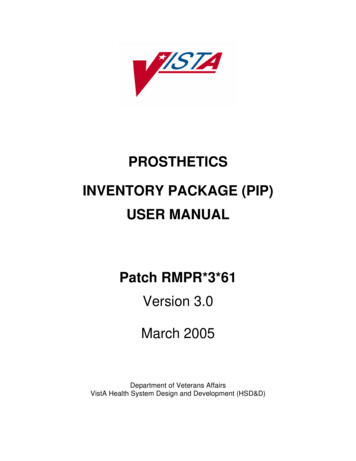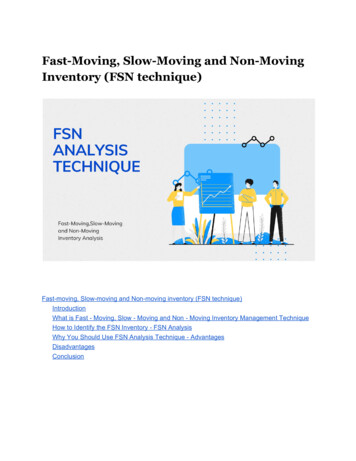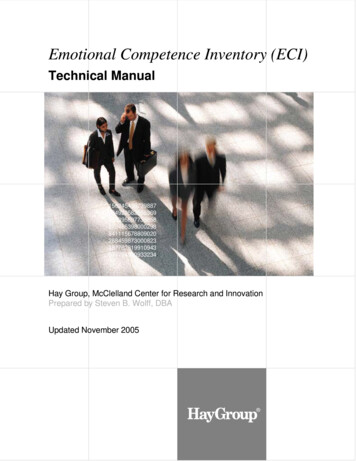
Transcription
Emotional Competence Inventory (ECI)Technical 62819910943377784930933234Hay Group, McClelland Center for Research and InnovationPrepared by Steven B. Wolff, DBAUpdated November 2005
Emotional Competence Inventory (ECI)Technical ManualHay GroupMcClelland Center for Research and InnovationUpdated by Steven B. Wolff, DBA*November 2005*The previous version of this manual (2002) was prepared by Fabio Sala, Ph.D
.
Table of ContentsSummary.1Reliability Overview . 1Validity Overview. 1Introduction.2Definition of Emotional Intelligence . 2Background on the ECI. 2A Brief History of the Development of the ECI . 2The Need for the ECI – 2.0 . 2Emotional Intelligence Framework. 3A Summary of Changes in ECI 2.0 vs. ECI 1.0. 4Using the ECI Appropriately . 4Developmental uses vs. Administrative uses . 5Scoring . 5Clustering of Competencies . 5Competency Levels. 6Use of Self Ratings . 6What is Considered Valid Data. 7Reliability ECI 2.0.9Internal Consistency for the ECI 2.0. 9Test-Retest Reliability . 11Validity.12Overall Validity Study Using ECI 2.0 . 12Criterion Validity Using ECI 1.0 . 14Emotional Intelligence and U.K. College Principals . 14Emotional Intelligence and Performance in the Turkish Finance Sector. 14Emotional Intelligence and South African Call Center Agents . 17EI, IQ, and Perceptions of Leadership . 17High Performance and High Potential at Johnson & Johnson . 18Emotional Intelligence and the Performance of school Principals . 19Leadership and Emotional Intelligence. 19Emotional Intelligence and Performance: Filipino First-Line Supervisors . 20Emotional Intelligence and Team Performance. 20Criterion Validity Using ECI 2.0 . 20ECI 2.0 and Sales Performance at Bass Brewers in the U.K. . 20ECI 2.0 and Performance with U.K. Fire Fighters and Fire Officers . 20Leadership, ECI 2.0, and Performance in Public Accounting Firm. 21ECI 2.0 and the performance of Division I softball coaches . 22ECI 2.0 and the performance of Parish leaders. 22Construct Validity Using ECI 1.0 . 22Type A and Type B Personality in Greek Bank Employees . 22Myers-Briggs Type Indicator (MBTI) and ECI in Paramedics. 23NEO Big Five Personality . 25Managerial Styles (Carulli & Com, 2003) . 25Emotional Intelligence Gap Scores and Managerial Styles . 26Emotional Intelligence Change Scores and Managerial Styles. 27Organizational Climate . 28U.K. College Principals Study (Sala, 2003) and Organizational Climate. 29Construct Validity Using ECI 2.0 . 30 2005 Hay Acquisition Company I, Inc. All rights reservedi0511-9889-HAYG
ECI 2.0 and Organizational Climate . 30ECI 2.0 and Irrational Beliefs . 31Leader EI, Emotionally Competent Group Norms, and Performance of Military Air Crews. . 31ECI 2.0 and Follower Commitment. 31Discriminant Validity Using ECI 1.0. 31Analytical Thinking and Emotional Intelligence . 31Discriminant Validity Using ECI 2.0. 32Personality and Emotional Intelligence . 32Convergent Validity Using ECI 2.0. 33German Translation of ECI 2.0 vs. Wong and Law Instrument . 33Emotional Intelligence Training and Development Using ECI 1.0 . 33Stress and Emotional Intelligence. 35Feedback: Self/Total Others Discrepancy Using ECI 1.0. 36Accurate Self-Assessment Study . 37Research on Demographic Variables Using ECI 1.0 . 38Promotions . 38Emotional Intelligence and Age. 38Emotional Intelligence and Job Characteristics . 38Gender and Emotional Intelligence. 39Research on Demographic Variables Using ECI 2.0 . 40Age, Gender, Educational Level and Emotional Intelligence. 40Age, Gender, Ethnicity and Emotional Intelligence . 40ECI 2.0 Descriptive Statistics.41Descriptive Statistics for the ECI 2.0. 41Inter-Competency Correlations. 42ECI 2.0 Norms.44Norms: Gender (Average-Item) . 44Norms: Gender (Scored) . 45Norms: Job Function (Average-Item 1 of 2). 46Norms: Job Function (Average-Item 2 of 2). 47Norms: Job Function (Scored 1 of 2). 48Norms: Job Function (Scored 2 of 2). 49Norms: Geography (Average-Item 1 of 2). 50Norms: Geography (Average-Item 2 of 2). 51Norms: Job Level (Average-Item 1 of 2). 52Norms: Job Level (Average-Item 2 of 2). 53Norms: Job Level (Scored 1 of 2). 54Norms: Job Level (Scored 2 of 2). 55ECI Frequently Asked Questions .56Conclusions.57ECI-U .58Validation Studies for the ECI-U. 58Construct Validity . 58Emotional Intelligence and Student Well-Being. 58Emotional Intelligence and Work Performance. 58Demographic Studies Using the ECI-U . 59ECI-U and Gender . 59References.61APPENDIX: Norms and Descriptive Statistics for the ECI 1.0 .67 2005 Hay Acquisition Company I, Inc. All rights reservedii0511-9889-HAYG
Reliability.67Internal Consistency for the ECI 1.0. 67ECI 1.0 Descriptive Statistics.68Means and Standard Deviations. 68Inter-Competency Correlations. 69ECI 1.0 Norms.70Overall Sample. 70Norms: Gender. 72Norms: Job Function. 73Norms: Geography. 74Norms: Job Level. 75 2005 Hay Acquisition Company I, Inc. All rights reservediii0511-9889-HAYG
2005 Hay Acquisition Company I, Inc. All rights reserved0511-9889-HAYG
SummaryThis technical manual provides background information on the ECI 2.0, reliability and validityinformation, and norms.Reliability OverviewInternal consistency reliability (Cronbach’s alpha) of the instrument has been found to be good for “totalothers” ratings. The reliabilities range from .68 (Transparency) to .87 (Emotional Self Awareness) withan overall average reliability of .78. The reliabilities of the “self” rating were not as good and rangedfrom .47 (Conflict Management) to .76 (Inspirational Leadership) with an overall average reliability of.63.Validity OverviewA number of studies are presented in the manual that highlight the criterion and construct validity of theinstrument. Research presented shows that ECI is related to outcomes such as an individual’s life success(Sevinc, 2001), department performance (Nel, 2001), perceptions of leadership in a group (Humphrey,Sleeth & Kellet, 2001), sales performance (Lloyd, 2001), fire fighter performance (Stagg & Gunter,2002), softball coaches win/loss record (VanSickle, 2004), and parishioner satisfaction (Brizz, 2004).The ECI also shows good construct validity and is related to measures such as the MBTI sensing/intuitingand thinking/feeling dimensions but not the introversion/extraversion and judging/perceiving dimensionsas expected (Burckle, 2000b). The ECI is correlated with affiliative and coaching leadership styles butnot coercive and authoritative styles (Carulli & Com, 2003). It has also been shown that ECI is related toclimate (Sala, 2003) although there is also evidence that ECI may not be directly related to climate butrather it affects climate through leadership style. Other research shows the ECI related to groupemotional intelligence (Stubbs, 2005), and negatively related to irrational beliefs as hypothesized (Welpe,Tumasjan, Stich et al., 2005).Two studies examined the discriminant validity of the ECI, i.e., that it is different from other concepts.The research shows that the ECI is not correlated with either critical thinking (Murensky, 2000) orpersonality traits as measured by Eysenck’s Personality Questionnaire (Zadel, 2004).Byrne (2003) conducted an overall validity study of the ECI using the self-scored version. He concludedthe instrument shows good construct, discriminant, and criterion validity. 2005 Hay Acquisition Company I, Inc. All rights reserved10511-9889-HAYG
IntroductionDefinition of Emotional IntelligenceEmotional intelligence is the capacity for recognizing our own feelings and those of others, for motivatingourselves and for managing emotions effectively in ourselves and others. An emotional competence is alearned capacity based on emotional intelligence that contributes to effective performance at work.Background on the ECIA Brief History of the Development of the ECIThe ECI is a 360-degree tool designed to assess the emotional competencies of individuals andorganizations. It is based on emotional competencies identified by Dr. Daniel Goleman in Working withEmotional Intelligence (1998), and on competencies from Hay/McBer’s Generic Competency Dictionary(1996) as well as Dr. Richard Boyatzis’s Self-Assessment Questionnaire (SAQ).Hay/McBer’s Generic Competency Dictionary was originated by Lyle and Signe Spencer as documentedin their book Competence at Work (1993), and revised by psychologist David McClelland after anextensive review of the literature. It is based on over 20 years of research initiated by Dr. McClelland(1973) with his seminal article, “Testing for Competence rather than Intelligence.” Hay/McBer and otherresearchers have established that every core competency in the Dictionary reliably differentiatesperformance in a variety of organizations.The Self-Assessment Questionnaire was initially developed by Dr. Boyatzis in 1991 for use with MBAand executive students to assess competencies in the Generic Model of Management used at theWeatherhead School of Management, Case Western Reserve University. The SAQ has shown a highdegree of construct validity against a variety of behavioral and questionnaire measures. Since 1991, it hasbeen used in numerous studies, including longitudinal research (Boyatzis, Baker, Leonard et al., 1995;Boyatzis, Cowen & Kolb, 1995).Expanding upon Dr. Boyatzis’s well-established evaluation measure, Dr. Boyatzis and Dr. Golemandeveloped a pool of items designed to capture the full spectrum of emotional competencies. Items wereselected from this pool based on conceptual and logical considerations. Hay/McBer consultants furtherrefined these items to reflect developmental scaling, which is characteristic of Hay/McBer’s GenericDictionary of Competencies. Developmental scales were designed and target levels were identified basedon expert opinion and prior studies.Boyatzis, Goleman, and Rhee (1999) outlined the rationale for the clustering and organization ofemotional intelligence competencies. This important paper presents a more detailed explanation for thedevelopment of the ECI and the theoretical structure upon which it is based.The Need for the ECI – 2.0There were a number of psychometric properties of the ECI that were not what we desired: (1) it wasreliable, but the competency scales showed intercorrelations that were too high (this resulted in a loss offactor differentiation and threatened the concept of EI having various components rather than being oneconstruct or score); (2) there was a desire to reduce the number of items (the feedback from clients wasthat the test, at 110 items, was too long); (3) we wanted to increase the validity, which was also threatenedif the scales were too highly correlated; and (4) in making changes, we wanted to ensure that wemaintained the high scale reliability. 2005 Hay Acquisition Company I, Inc. All rights reserved20511-9889-HAYG
The sample of over 10,000 ECIs taken between March, 1999 and May, 2001 provide “total others” itemscores on over 4,000 managers and professionals from various countries. This data set was compiled andanalyzed.The method of analysis was as follows: (1) look for items with the best Cronbach's alphas to theirintended scale; (2) using a confirmatory factor analysis with oblique rotations, look for items that loadedexclusively or predominantly on one scale and with other items from that intended scale; (3) drop itemsthat had item-to-scale correlations with multiple scales greater than .60; (4) drop items for which morethan 7% were left blank. This meant that people left this item blank and gave no response, suggesting itmight be difficult to observe the behavior in others, or the item wording was confusing; (5) Look foritems conceptually at the center of the definition of the EI competency; (6) look for items with distributedlevels; and (7) identify items that had confusing or multiple phrases.These steps were used to identify the best three items per scale. In most scales, this was possible. For afew there were still four or five of equal attractiveness. Cronbach's alphas were run using only these itemsand reliabilities were found to be similar to the earlier ones. This provided confidence that we couldreduce the number of items in the test while maintaining the structural integrity of the instrument.Since reverse scoring a few items could help minimize the effect of response set bias, we identified itemsthat would be candidates for reverse scoring. We reviewed items from within this short list that hadconfusing or multiple phrases (calling for mixed or confusing logic) and made edits to reduce the numberof words and increase clarity.Emotional Intelligence FrameworkThe Emotional Competence Inventory 2.0 (ECI) measures 18 competencies organized into four clusters:Self-Awareness, Self-Management, Social Awareness, and Relationship Management.Self-Awareness concerns knowing one's internal states, preferences, resources, and intuitions. The SelfAwareness cluster contains three competencies: Emotional Awareness: Recognizing one's emotions and their effectsAccurate Self-Assessment: Knowing one's strengths and limitsSelf-Confidence: A strong sense of one's self-worth and capabilitiesSelf-Management refers to managing ones' internal states, impulses, and resources. The SelfManagement cluster contains six competencies: Emotional Self-Control: Keeping disruptive emotions and impulses in checkTransparency: Maintaining integrity, acting congruently with one’s valuesAdaptability: Flexibility in handling changeAchievement: Striving to improve or meeting a standard of excellenceInitiative: Readiness to act on opportunitiesOptimism: Persistence in pursuing goals despite obstacles and setbacksSocial Awareness refers to how people handle relationships and awareness of others’ feelings, needs, andconcerns. The Social Awareness cluster contains three competencies: Empathy: Sensing others' feelings and perspectives, and taking an active interest in their concernsOrganizational Awareness: Reading a group's emotional currents and power relationshipsService Orientation: Anticipating, recognizing, and meeting customers' needs 2005 Hay Acquisition Company I, Inc. All rights reserved30511-9889-HAYG
Relationship Management concerns the skill or adeptness at inducing desirable responses in others. TheRelationship Management cluster contains six competencies: Developing Others: Sensing others' development needs and bolstering their abilitiesInspirational Leadership: Inspiring and guiding individuals and groupsChange Catalyst: Initiating or managing changeInfluence: Wielding effective tactics for persuasionConflict Management: Negotiating and resolving disagreementsTeamwork & Collaboration: Working with others toward shared goals. Creating group synergy inpursuing collective goals.A Summary of Changes in ECI 2.0 vs. ECI 1.0Several name or label changes were made to clarify meaning of scales:Leadership became Inspirational Leadership;Trustworthiness became Transparency;Achievement Orientation became AchievementSelf-Control became Emotional Self-Control; andThe Social Skills cluster became the Relationship Management cluster.For ease of use and brevity, Conscientiousness and Communication were dropped. It has been clear fromusers of the ECI and recent research that these competencies do not differentiate outstanding performancefor many managers or professional samples. Also, due to high intercorrelation and conceptual closeness,Building Bonds was integrated into Teamwork. The Optimism competency scale was added back ontothe ECI (it had been dropped from the original when creating the ECI 1.0).To summarize action taken on the scales:Conscientiousness was dropped;Communication was dropped;Building Bonds was integrated into Teamwork; andOptimism was added.Another major action was to change the response set from a 1–7 scale (calling for the degree to which onefelt the item was characteristic of the person being assessed). The new response set reflects one’sobservation of the frequency with which the person being assessed demonstrates the behavior or nature ofthe item. The six behavioral anchors are:1 Never2 Rarely3 Sometimes4 Often5 Consistently6 Don't KnowUsing the ECI AppropriatelyThe ECI can be used by practitioners for assessment and development as well as researchers for studyingemotional intelligence. There are a number of issues that must be understood about the instrument if it isto be used appropriately. 2005 Hay Acquisition Company I, Inc. All rights reserved40511-9889-HAYG
Developmental uses vs. Administrative usesThe ECI is not intended to be used for administrative purposes, e.g., selection, promotion, salarydecisions, etc. The proper use of the ECI is for developmental purposes only. Although the instrument isvalid across a broad array of situations and has been found to be reliable, it is designed to be general innature. Each competency measured by the ECI may or may not be relevant to any specific job, thus it isinappropriate to use the ECI for administrative purposes without first validating it against the performancerequirements for that job. However, because the ECI is intended to apply broadly, it is an excellent toolfor developmental purposes. Feedback is only to be given by accredited users, thus, researchers shouldnot give individual feedback to participants in their study unless they are accredited to do so. An overallsummary of the study results without individual data is an appropriate level of feedback for unaccreditedresearchers to provide to participants.ScoringWhen the ECI is scored by the HayGroup, feedback reports reflect a proprietary algorithm for combiningrater scores. These scores are different from those calculated by researchers, who generally use averageitem scores. Where available, both the scored and average-item norms are reported later in this manual,be sure to use the appropriate ones for your purposes. Generally, practitioners are interested in the scoreddata while researchers are interested in the average-item data.Clustering of CompetenciesThe ECI represents a set of competencies related to emotional intelligence. As with any competencymodel, one must not assume that a person must be rated high on all competencies to be effective.Boyatzis, Goleman, and Rhee (1999) argue that ECI competencies can be organized into clusters. Withinany cluster the competencies have one of four relationships: “First, they may be parts of a whole andcomplement each other in functional behavior (e.g., Adaptability and Conscientiousness). Second, theymay be alternate manifestations. The specific competency used would vary by setting or stimulus. Third,the competencies within the cluster may be compensatory. That is, using one competency makes up forusing less of another (e.g., Achievement Orientation and Initiative). Fourth, the competencies within thecluster may be antagonistic. Frequent use of one “crowds” out the ease or possible use of another (e.g.,Self-control vs. Initiative). If someone demonstrates a great deal of Self-control and inhibits theirimpulses and actions, they would have an increasingly difficult time demonstrating Initiative and startingthings before anyone asks.”The implication of competency clustering is that it does not make sense, on a theoretical basis, to obtainan overall ECI score by simply averaging the scores for all competencies in all clusters. A researcher orpractitioner must not assume that
Definition of Emotional Intelligence Emotional intelligence is the capacity for recognizing our own feelings and those of others, for motivating ourselves and for managing emotions effectively in ourselves and others. An emotional competence is a learned capacity based on emotional intelligence that contributes to effective performance at work.
